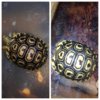- Joined
- Nov 17, 2012
- Messages
- 3,331
I figured since I post pictures of my leopard tortoise group quite often it might be best to create my own thread that way a story is told over time. So here is my group minus two more 3month olds I will be receiving once it warms up.
Now I will be the first to admit that I have mistakes over the last 2 years working with this species that I wish I could go back and correct, but unfortunately sometimes we simply have to live and learn. I would love to say that every tortoise I acquired lived and was flourishing but I have lost a handful over the last two years for various reasons.
First and foremost I'm certain some of my babies that didn't make it were simply victims of hatchling failure syndrome. They would look great for a month or so then turn south in a flash while others in the exact same care were flourishing. Others were lost to a vicious ant invasion last winter that broke my heart.
I hope to share what I've experienced over the last few years to help others avoid the same heartache.
I'm by no means an expert on this species yet, but I feel that my experience is starting to narrow down a good path of raising these beautiful tortoises. I owe A TON to the loyal members of TFO that have raised and are currently working with this species and sharing their knowledge. My hope is that this thread can participate in the growing knowledge of this wonderful species so we can begin to see more and more babies reach adulthood.
Here is a quick (and honest) recap of my group with pictures below.
Now I will be the first to admit that I have mistakes over the last 2 years working with this species that I wish I could go back and correct, but unfortunately sometimes we simply have to live and learn. I would love to say that every tortoise I acquired lived and was flourishing but I have lost a handful over the last two years for various reasons.
First and foremost I'm certain some of my babies that didn't make it were simply victims of hatchling failure syndrome. They would look great for a month or so then turn south in a flash while others in the exact same care were flourishing. Others were lost to a vicious ant invasion last winter that broke my heart.
I hope to share what I've experienced over the last few years to help others avoid the same heartache.
I'm by no means an expert on this species yet, but I feel that my experience is starting to narrow down a good path of raising these beautiful tortoises. I owe A TON to the loyal members of TFO that have raised and are currently working with this species and sharing their knowledge. My hope is that this thread can participate in the growing knowledge of this wonderful species so we can begin to see more and more babies reach adulthood.
Here is a quick (and honest) recap of my group with pictures below.



























